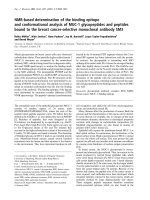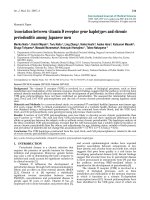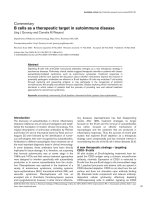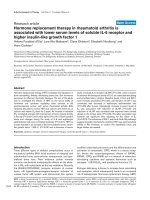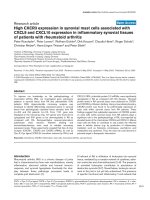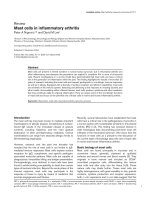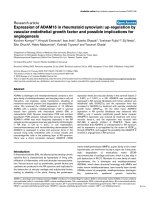Báo cáo y học: "Nurse-like cells reside in the synovial tissue and bone marrow in rheumatoid arthritis" doc
Bạn đang xem bản rút gọn của tài liệu. Xem và tải ngay bản đầy đủ của tài liệu tại đây (138.85 KB, 6 trang )
Page 1 of 6
(page number not for citation purposes)
Available online />Abstract
A major question concerning the immunopathology of rheumatoid
arthritis is why the disease is localized to particular joints. A
possible explanation could be the presence within the synovium of
cells that foster inflammation or easy accessibility of the synovium
to migratory disease enhancing cells. Within both the bone marrow
and the synovium, fibroblastic stromal cells play an important role
in supporting the differentiation and survival of normal cells, and
also contribute to the pathologic processes. Among fibroblastic
stromal cells in synovial tissue and bone marrow, nurse-like cells
are a unique population having the specific capacity to promote
pseudoemperipolesis (adhesion and holding beneath) of
lymphocytes, and also the ability to promote the growth and
function of some populations of lymphocytes and monocytes.
Nurse-like cells could therefore contribute to the immuno-
pathogenesis of rheumatoid arthritis, and may contribute to the
localization of inflammation within specific joints. The present
review considers the evidence that supports these possibilities.
Introduction
Rheumatoid arthritis (RA) is a chronic autoimmune disease
characterized by immunologically enhanced inflammation and
damage to articular structures [1,2]. Rheumatoid synovium is
a site of intense inflammation, with active involvement by
various populations of infiltrating lymphocytes, myeloid cells,
and resident synovial fibroblasts or synoviocytes [1]. One
question that has not been addressed is why RA
preferentially affects certain joints. Although the explanation
for the localization of rheumatoid inflammation to particular
joints is not clear, one possibility relates to the presence
within the synovium of resident cells that can promote
inflammation. In addition, cells that can be induced to migrate
from adjacent bone marrow structures may contribute to the
local facilitation and propagation of inflammation and bone
damage. The present review will focus on one such
population, the nurse-like cells (NLCs) that populate the
rheumatoid synovium and bone marrow.
Fibroblastic stromal cells in bone marrow
and synovial tissue
Initially, to examine the relationship between the epiphyseal
bone marrow and synovial tissue, we employed the animal
model of collagen-induced arthritis [3]. Fibroblastic stromal
cells (FSCs) in the bone marrow of Lewis rats were labeled
with a fluorescent probe or
3
HTdr and were examined for
their migration at the onset of arthritis [4]. Accompanying the
induction of polyarthritis, a large number of labeled FSCs in
bone marrow were found to migrate into the joint cavity
through canals observed in the bare zone of the joint
(Figure 1), and then to proliferate in the synovial tissue. This
observation suggested the hypothesis that pathophysio-
logical cells of RA could be produced in bone marrow, from
which some of these cells could migrate into the joint space
and potentially play roles in inflammation or tissue damage in
and around articular structures. Based on these findings, we
have studied FSCs of RA patients, comparing the
characteristics of FSCs from bone marrow and FSCs from
synovial tissue [5-7].
Nurse-like cells found in bone marrow and
synovial tissue
Among the FSCs derived from the bone marrow and
synovium of RA patients, a population of NLCs was identified
by the capacity to carry out pseudoemperipolesis. The
Review
Mesenchymal stromal cells
Nurse-like cells reside in the synovial tissue and bone marrow in
rheumatoid arthritis
Takahiro Ochi
1
, Hideki Yoshikawa
2
, Tomoko Toyosaki-Maeda
3
and Peter E Lipsky
4
1
Sagamihara National Hospital, Sagamihara, Kanagawa, Japan
2
Department of Orthopaedic Surgery, Osaka University Medical School, Suita, Osaka, Japan
3
Department of Immunology, Shionogi Research Laboratories, Shionogi & Co. Ltd, Osaka, Japan
4
National Institute of Arthritis and Musculoskeletal and Skin Diseases, Bethesda, MD 20892, USA
Corresponding author: Takahiro Ochi,
Published: 12 February 2007 Arthritis Research & Therapy 2007, 9:201 (doi:10.1186/ar2105)
This article is online at />© 2007 BioMed Central Ltd
BST-1 = bone marrow fibroblastic stromal cell antigen 1; FSC = fibroblastic stromal cell; GM-CSF = granulocyte/macrophage colony-stimulating
factor; HLA = human major histocompatibility antigen; IFN = interferon; IL = interleukin; mAb = monoclonal antibody; NLC = nurse-like cell; RA =
rheumatoid arthritis; RANKL = receptor activator of NF-κB ligand; TNF = tumor necrosis factor; TRAP = tartarate-resistant acid phosphatase.
Page 2 of 6
(page number not for citation purposes)
Arthritis Research & Therapy Vol 9 No 1 Ochi et al.
function of the NLCs was reminiscent of thymic nurse cells
[8,9], which have the capacity to interact with populations of
thymic cells and gather them beneath their cell bodies in a
process known as pseudoemperipolesis (adhesion and
holding beneath). In vivo, such thymic nurse cells were
thought to support the development and expansion of
thymocytes and to also play a role in positive/negative
selection of T cells in mouse and rat thymus. A very similar
capacity to interact and support the maturation of some
population of lymphocytes and monocytes was noted for
FSCs of bone marrow [5,7] and for FSCs of synovial tissue
[6,7] of RA patients, suggesting that the NLC function of
FSCs could contribute to the pathophysiology of RA [7].
We established RA-NLC clones with the ability to promote
pseudoemperipolesis from bone marrow [5] and synovial
tissue [6] of RA patients. These RA-NLC clones were
determined to be of mesenchymal origin, given that they
expressed vimentin but not cytokeratin. They did not exhibit
desmosomes or classical junctional complexes, both of which
are characteristic features of epithelial cells. Elongated and
branching mitochondria were present in the cytoplasm of the
clones, and caveolae, which are unique to cells of mesen-
chymal origin, were present on the surface [5,6].
NLCs have a number of unique functional activities that could
contribute to rheumatoid inflammation. Among these activities
are their ability to promote antibody production by B cells, the
capacity to protect lymphocytes from apoptosis, the ability to
secrete large amounts of cytokines and chemokines that
could promote the accumulation and activation of lympho-
cytes and monocytes, and their unique capacity to promote
the differentiation of osteoclasts from myeloid precursors in a
receptor activator of NF-κB/receptor activator of NF-κB
ligand (RANKL)-independent manner [10].
Multipotent mesenchymal stem cells from bone marrow were
also found to exist in the synovial membrane [11-14]. Those
cells were shown to have multipotency to develop into
various cells such as cartilage, bone, fat, and muscle.
Although it is currently unknown whether these cells can
differentiate into NLCs, RA-NLCs are a more differentiated
population. Multipotential mesenchymal stem cells from the
synovial fluid and bone marrow of patients with inflammatory
and degenerative arthritis were reported to be negative for
CD45 and to be positive for D7-FIB, CD13, CD105, CD55,
and CD10 [13]; these mesenchymal stem cells therefore
have a very different phenotype from that of RA-NLCs
mentioned in the following.
Surface phenotype of rheumatoid arthritis
nurse-like cells
RA-NLC clones from bone marrow and synovial tissue [5-7]
expressed CD29, CD44, CD49c, CD54, CD106, and
HLA-A, HLA-B, and HLA-C (class I major histocompatibility
complex), but did not express CD1a, CD18 (LFA-1), CD35,
CD40, CD154, or CD56. RA-NLCs constitutively expres-
sed CD106 after long-term culture in the absence of cyto-
kine stimulation. Constitutive expression of CD106 appears
to be a characteristic appearance of nurse cell lines,
permitting them to be distinguished from fibroblasts [7].
Human dermal fibroblast also expressed CD29, CD49c,
CD54, and class I major histocompatibility complex, where-
as constitutive expression of CD106 was minimal. IFNγ
(100 U/ml) stimulation of RA-NLCs induced expression of
CD40 and HLA-DR (class II major histocompatibility
complex), but not expression of CD35 or CD154. The
surface phenotype of RA-NLCs was therefore similar to that
of FSCs derived from synovial tissue and bone marrow cells
from non-RA controls. Namely, the phenotype of NLCs
derived from osteoarthritis patients and human skin nurse
cells was similar to that of RA-NLCs. Enhanced expression
of CD106 and CD157 by IFNγ (mentioned below) was the
characteristic observation in RA-NLCs and was different
from human dermal fibroblasts [7].
Expression of CD106 by RA-NLCs was modestly enhanced
by culture with normal peripheral B cells, and was markedly
enhanced by IFNγ. In contrast, expression of CD106 by
human dermal fibroblasts was much less marked after
stimulation with IFNγ or by culture with peripheral B cells.
One of the features of NLCs is their capacity to promote the
survival of B lymphocytes [5-7]. Such B-cell survival was
reduced by a blocking anti-CD106 mAb to the same level as
B cells cultured in medium alone.
One notable product of NLCs is human bone marrow
fibroblastic stromal cell antigen 1 (BST-1). This product was
originally cloned from a human bone marrow FSC cell line by
surveying for any unknown factors [15], supporting the FSC-
dependent growth of the murine pre-B-cell line DW34. A
new growth factor was identified, having the ability to
enhance DW34 cell growth, and it was designated BST-1
[16]. Human BST-1 is expressed in various tissues and cell
Figure 1
Migration of fibroblastic stromal cells from epiphyseal bone marrow
(BM) into the joint space (JS) forming synovial (Sy) tissue in collagen-
induced arthritis. C, cartilage.
Page 3 of 6
(page number not for citation purposes)
lines, such as umbilical vein endothelial cells, myeloid cells,
as well as FSCs of bone marrow and also synovial cells in
RA, but is not expressed in lymphoid cell lines. Notably,
serum levels of BST-1 were higher (30-fold to 50-fold) in 7%
of RA patients than in non-RA samples [17]. Human BST-1
was later designed as CD157, and the human Bst-1 gene
was assigned to chromosome 4q15, regulating humoral
immune responses in vivo [18]. Expression of CD157
(BST-1) was detected on all RA-NLCs, as well as on human
dermal fibroblasts. Expression of CD157 by RA-NLCs, but
not by dermal fibroblasts, was enhanced by IFNγ. This
enhancement was much more marked with bone marrow-
derived RA-NLCs compared with synovium-derived RA-
NLCs. It should be noted that expression of CD106 and
CD157 mRNA was found in all RA-NLC clones. Soluble
CD157 together with RA-NLCs further increased the
survival of B cells, which was reduced by a blocking anti-
CD157 polyclonal antibody [7].
Cytokine production by nurse-like cells of RA
patients
RA-NLCs produced numerous cytokines [5-7]. RA-NLCs
from both bone marrow and synovial tissue produced
detectable levels of IL-6, IL-8, and granulocyte/macrophage
colony-stimulating factor (GM-CSF), and the production of
IL-6 and IL-8 was quite robust. RA-NLCs from bone marrow
but not synovial tissue produced IL-7, whereas RA-NLCs
from synovial tissue produced granulocyte colony-stimulating
factor and a greater amount of IL-6. Regulation of the
production of cytokines was examined by co-culture of
RA-NLCs from synovial tissue in direct contact with B cells.
Secretion of IL-6, IL-8, granulocyte colony-stimulating factor,
and GM-CSF was markedly increased by co-culture with B
cells. IL-1β and TNF were only detected in the culture super-
natants after co-culture with B cells. The effect of co-culture
with B lymphocytes on the secretion of cytokines and immuno-
globulin production by the B cells were examined under
various culture conditions [5-7] (Table 1). After co-culture
with B cells, the levels of IL-6, IL-8, granulocyte colony-
stimulating factor, GM-CSF, and the levels of IgM were
increased, and IL-1β and TNF were detected. Direct contact
with the B-cell clone was required for RA-NLCs to produce
IL-1β and TNF and higher levels of the other cytokines.
Inhibition of spontaneous apoptosis of
lymphocytes and the effect of adhesion
molecules
RA-NLCs were found to promote lymphocyte viability.
Although peripheral blood B cells cultured in medium alone
rapidly died, culture of B cells with RA-NLCs markedly
increased the B-cell viability. The loss of viability of B cells
cultured alone related to the induction of apoptosis, whereas
co-culture of B cells with RA-NLCs substantially blocked their
apoptosis. The mechanism of the prevention of apoptosis of
B cells involved the contact-dependent upregulation of Bcl-x
L
by RA-NLCs [19].
The regulation of pseudoemperipolesis (adhesion and
holding beneath) by RA-NLCs was examined using MC/car
cells and a cloned RA-NLC line from synovial tissue [20].
Pretreatment with anti-CD29 (integrin β
1
chain) or anti-CD49d
(integrin α
4
chain) reduced adhesion by MC/car cells by
approximately 50%. This result indicated that integrin α
4
β
1
(very late antigen 4) on MC/car cells was involved, at least in
part, in the cells’ ability to participate in pseudoemperipolesis
with RA-NLCs, although such interactions were not involved in
IL-6 and IL-8 production by RA-NLCs. Pretreatment of MC/car
cells with the Rho-specific inhibitor C3 transferase
significantly inhibited the migration of MC/car cells underneath
RA-NLCs in a concentration-dependent manner, whereas the
same treatment did not inhibit the adhesion of the MC/car
cells to RA-NLCs. In addition, RA-NLCs produced
comparable levels of IL-6 and IL-8 when co-cultured with C3-
treated transmigration-defective MC/car cells. The processes
of pseudoemperipolesis, adhesion and holding beneath were
therefore thought to be independent events [20]. Moreover,
very late antigen 4 (α
4
β
1
)-independent lymphocyte adhesion
and not holding beneath induced the enhanced
proinflammatory cytokine production by the RA-NLCs [20].
Regarding NLCs, another group reported that CD14(+)
monocytes could differentiate into NLCs and support the
viability of chronic lymphocytic leukemia B cells [21-23], and
also support the viability of primary B cells in RA [24,25].
These effects were dependent on interactions between RA-
NLC-expressed CD106 and B-cell-expressed very late
antigen 4 [24], which were quite similar to the interactions
between RA-NLCs and B cells we had previously reported
[7]. Although the other group’s NLCs were identified to be
derived from CD14 myelomonocytic cells [22,23,25] we have
not yet clarified the stem cell of our RA-NLCs, but it clearly
appears to be of mesenchymal origin [5,6].
RANKL-independent differentiation of
osteoclast-like cells supported by RA
nurse-like cells
RA-NLCs also promoted a specific pathway of the differen-
tiation of CD14(+) monocytes. After 3–4 weeks of co-culture,
CD14(+) monocytes differentiated into tartarate-resistant
acid phosphatase (TRAP)(+) mononuclear cells with
abundant cytoplasm and an off-center nucleus without the
involvement of RANKL. It was noted that RA-NLCs supported
such differentiation of peripheral blood CD14(+) monocytes
not only from RA patients, but also from normal control
subjects [10]. The second step of differentiation from such
TRAP(+) mononuclear cells into multinucleated bone-
resorbing giant cells (osteoclast-like cells) could also be
induced without RANKL in the presence of IL-3, IL-5, IL-7, or
GM-CSF, and was inhibited by mAb to each cytokine [10].
Differentiation of these TRAP(+) mononuclear cells into
multinucleated bone-resorbing giant cells could also be
promoted by macrophage colony-stimulating factor and
RANKL [26].
Available online />Expression of MMP-2, MMP-9, and MMP-12 was increased
in both TRAP(+) mononuclear and multinucleated cells after
differentiation by culture with RA-NLCs, and these cells could
induce cartilage degeneration in vitro by a mechanism that
was completely blocked by inhibitors of MMP-2 and MMP-9.
Although MMP-2 expression was significantly increased in
TRAP(+) mononuclear cells, expression of MMP-9 and
MMP12 was also higher in TRAP(+) multinucleated cells
[27]. Of note, both TRAP(+) mononuclear and multinucleated
cells differentiated by culture with RA-NLCs specifically
expressed MMP-12 [27], whereas multinucleated cells
expressing MMP-12 were clearly found near the bone
erosions (S Yamane, M Maeda-Tanimura, Y Shimaoka, M
Yukioka, T Toyosaki-Maeda, S Ishida, N Yamane, Y Tsuruta, T
Itoh, N Fukui, et al., unpublished observation). RA-NLCs were
therefore found to promote the differentiation of CD14(+)
monocytes in a characteristic two-step differentiation process
into multinucleated osteoclast-like cells with the capacity to
degrade bone and cartilage.
Although TNF [28], IL-1 [29], macrophage colony-stimulating
factor, and RANKL [30] are very important factors for
developing osteoclasts, the RANKL-independent two-step
differentiation of CD14(+) monocyte supported by RA-NLCs
[10,26] may be an alternative pathway to develop multi-
nucleated osteoclast-like cells specifically in RA. Beside the
destruction of bone tissue by osteoclasts or osteoclast-like
cells, we could confirm that FSCs from RA patients
inoculated in vivo showed aggressive behavior, invading
cartilage as reported previously [31-33], although we have
not yet confirmed that pure RA-NLC lines have such function.
Comparison of the properties of RA nurse-
like cells and fibroblast-like synoviocytes
A considerable amount of work has characterized another
population of cells found in the rheumatoid synovium, namely
fibroblast-like synoviocytes. The cells are thought to play a
role in rheumatoid pathogenesis, especially because of their
capacity to contribute to tissue damage [31-33]. RA-NLCs,
however, have a number of specific attributes that suggest
they may play a unique role in RA pathogenesis (Table 2).
Mechanisms of progressive proliferation of
fibroblastic stromal cells specifically found in
joint
To explain the remarkable proliferation of synovial tissue in
the RA patient, various mechanisms have been reported
such as the involvement of protooncogenes [34],
inflammatory cytokines [35], and perturbations of Fas-
mediated apoptosis [36]. As a mechanism specifically
found in the synovial space but not in the bone marrow, we
found that the interference with Fas-mediated apoptosis
could upregulate specifically the growth of synovial FSCs
[37,38]. In this regard, soluble Fas ligand was found to
inhibit competitively the Fas–Fas ligand-mediated apoptosis
[37] of FSCs bearing Fas. The levels of human soluble Fas
ligand in synovial fluid from RA patients were found to be
significantly higher than those from osteoarthritis patients.
Arthritis Research & Therapy Vol 9 No 1 Ochi et al.
Page 4 of 6
(page number not for citation purposes)
Table 1
Effects of co-culture on production of cytokines from rheumatoid arthritis nurse-like cells (RA-NLCs)
Cytokines in cell culture supernatant (pg/ml)
a
IgM (µg/ml)
a
Experiment Experiment
IL-1α IL-1β IL-6 IL-7 IL-8 G-CSF GM-CSF TNFα TNFβ 23
Cytokine production from RA-NLCs derived from synovium and immunoglobulin from B cells
b
[6]
RA-SNCs <5.0 <10.0 2,200 4,300 460 40 <5.0 <5.0 <1.5 <1.5
B cells <5.0 <10.0 <10.0 <10.0 <10.0 <2.5 <5.0 <5.0 1.8 2.7
B cells + RA-SNCs (separated)
c
<5.0 <10.0 1,800 3,900 510 30 <5.0 <5.0 <1.5 <1.5
B cells + RA-SNCs <5.0 153 15,900 34,500 2,400 740 690 <5.0 5.6 8.6
Cytokine production from RA-NLCs derived from bone marrow cells
d
[5]
RA-BMNC-1 cell line – – 38,250 – 1,480 – 150 –
+ MC/car cell line – 320 89,015 – 33,510 755 915 275
+ Molt-17 cell line – 235 78,750 – 10,615 540 355 255
RA-BMNCs, cytokine production from RA-NLCs derived from bone marrow cells; RA-SNCs, cytokine production from RA-NLCs derived from
synovium; G-CSF, granulocyte colony-stimulating factor; GM-CSF, granulocyte/macrophage colony-stimulating factor; –, not detectable.
a
The amount of each cytokine and IgM in the culture supernatant was measured with an enzyme-linked immunosorbent assay kit.
b
B-cell clones
(1 × 10
5
) and RA-SNC3 (5 × 10
4
) were cultured under the indicated conditions for 3 days in 24-well plates.
c
B-cell clones were cultured in a
Millicell culture insert.
d
RA-BMNC cells (3 × 10
4
cells/well) were inoculated and cultured overnight, and 1 × 10
6
cells MC/car cells or Molt-17 cells
were added to the culture. After 5 days of incubation, the culture supernatants were collected and the amount of each cytokine in the culture
supernatant was measured with an enzyme-linked immunosorbent assay kit.
In contrast, soluble Fas ligand was not detected in the
peripheral blood, and also not in bone marrow blood in RA
patients [38]. This mechanism, therefore, could at least
partially upregulate the FSC growth in synovial tissue, but
not in bone marrow.
Conclusion
A specific population of FSCs, RA-NLCs reside in both the
bone marrow and synovium of RA patients and have the
functional capacity to interact with lymphocyte and monocyte
populations, inducing cellular differentiation and biologic
activities that mimic pathophysiologic features of rheumatoid
inflammation. These findings suggest that RA-NLCs may play
an essential role in the development of local immune and
inflammatory responses in the synovium and the bone
marrow. RA-NLCs could therefore be central elements in the
pathologic events in RA and might be appropriate targets for
therapeutic intervention in RA.
Competing interests
The authors declare that they have no competing interests.
Acknowledgements
The work reported here has been supported in part by a grant-in-aid
from the Health Science Research grant from the Ministry of Health and
Welfare of Japan. The authors are grateful for the great collaboration
and support of the people listed in each paper related to this review.
Among them, we are especially grateful to Dr T Kishimoto, Dr T Hirano,
Dr S Nagata, Dr T Suda, Dr M Miyasaka, Dr T Kaisho, and Dr K Ishihara
of Osaka University Medical School, and to Dr R Suzuki and Miss T
Uchida of the Research Center, Sagamihara National Hospital.
References
1. Eisenberg RA, Cohen PL: The role of immunologic mecha-
nisms in the pathogenesis of rheumatic disease. In Primer on
the Rheumatic Diseases. 10th edition. Edited by Schumacher HR,
Klippel JH, Koopman WJ. Atlanta: Arthritis Foundation; 1993:27-
35.
2. Genant HK: Radiology of rheumatic diseases. In Arthritis and
Allied Conditions. 9th edition. Edited by McCarty DJ. Philadel-
phia: Lea & Febiger; 1979:70-130.
3. Trentham D, Townes A, Kang A: Autoimmunity to type II colla-
gen: an experimental model of arthritis. J Exp Med 1977, 146:
857-868.
4. Nakagawa S, Toritsuka Y, Wakitani S, Denno K, Tomita T, Owaki
H, Kimura T, Shino K, Ochi T: Bone marrow stromal cells con-
tribute to synovial cell proliferation in rats with collagen
induced arthritis. J Rheumatol 1996, 23:2098-2103.
5. Tomita T, Takeuchi E, Toyosaki-Maeda T, Oku H, Kaneko M,
Takano H, Sugamoto K, Ohzono K, Suzuki R, Ochi T: Establish-
ment of nurse-like stromal cells from bone marrow of
patients with rheumatoid arthritis: indication of characteristic
bone marrow microenvironment in patients with rheumatoid
arthritis. Rheumatology 1999, 38:854-963.
6. Takeuchi E, Tomita T, Toyosaki-Maeda T, Kaneko M, Takano H,
Hashimoto H, Sugamoto K, Suzuki R, Ochi T: Establishment and
characterization of nurse cell-like stromal cell lines from syn-
ovial tissues of patients with rheumatoid arthritis. Arthritis
Rheum 1999, 42:221-228.
7. Shimaoka Y, Attrep JF, Hirano T, Ishihara K, Suzuki R, Toyosaki T,
Ochi T, Lipsky PE: Nurse-like cells from bone marrow and syn-
ovium of patients with rheumatoid arthritis promote survival
and enhance function of human B cells. J Clin Invest 1998,
102:606-618.
8. Wekerle H, Ketelsen UP: Thymic nurse cells – Ia bearing
epithelium involved in T-lymphocyte differentiation? Nature
1980, 283:402-404.
9. Wekerle H, Ketelsen UP, Ernst M: Thymic nurse cells. Lym-
phoepitherial cell complexes in murine thymuses: morpho-
logical and serological characterization. J Exp Med 1980, 161:
925-944.
10. Toyosaki-Maeda T, Takano H, Tomita T, Tsuruta Y, Maeda-Tan-
imura M, Shimaoka Y, Takahashi T, Iton T, Suzuki R, Ochi T: Dif-
ferentiation of monocytes into multinucleated giant
bone-resorbing cells: two-step differentitaion induced by
nurse-like cells and cytokines. Arthritis Res 2001, 3:306-310.
11. De Bari C, Dell’Accio F, Tylzanowski P, Luyten FP: Multipotent
mesenchymal stem cells from adult human synovial mem-
brane. Arthritis Rheum 2001, 44:1928-1942.
12. De Bari C, Dell’Accio F, Vanlauwe J, Eyckmans J, Khan IM, Archer
CW, Jones EA, McGonagle D, Mitsiadis TA, Pitzalis C, Luyten FP:
Mesenchymal multipotency of adult human periosteal cells
demonstrated by single-cell lineage analysis. Arthritis Rheum
2006, 54:209-1221.
13. Jones EA, English A, Henshaw K, Kinsey SE, Markham AF, Emery
P, McGonagle D: Enumeration and phenotypic characteriza-
tion of synovial fluid multipotential mesenchymal progenitor
Available online />Page 5 of 6
(page number not for citation purposes)
Table 2
Comparison of the properties of rheumatoid arthritis nurse-like cells and fibroblast-like synoviocytes
Rheumatoid arthritis Fibroblast-like
Property nurse-like cells synoviocytes
Pseudoemperipolesis + –
Constitutive expression of CD106 + –
Enhanced expression of CD106 and CD157 by IFNγ +–
Promote B-cell differentiation + –
Promote differentiation of osteoclast-like cells from CD14(+) monocytes + –
Inhibit lymphocyte apoptosis + –
This review is part of a series on
Mesenchymal stromal cells
edited by Steffen Gay.
Other articles in this series can be found at
/>review-series.asp?series=ar_Mesenchymal
cells in inflammatory and degenerative arthritis. Arthritis
Rheum 2004, 50:817-827.
14. Jones EA, English A, Kinsey SE, Straszynski L, Emery P, Ponchel
F, McGonagle D: Optimization of a flow cytometry-based pro-
tocol for detection and phenotypic characterization of multi-
potent mesenchymal stromal cells from human bone marrow.
Cytom Part B (Clin Cytom) 2006, 70B:391-399.
15. Kaisho T, Oritani K, Ishikawa J, Tanabe M, Muraoka O, Ochi T,
Hirano T: Human bone marrow stromal cell lines from
myeloma and rheumatoid arthritis that can support murine
pre-B cell growth. J Immunol 1992, 149:4088-4095.
16. Kaisho T, Ishikawa J, Oritani K, Inazawa J, Tomizawa H, Muraoka
O, Ochi T, Hirano T: BST-1, a surface molecule of bone
marrow stromal cell lines that facilitates pre-B-cell growth.
Proc Natl Acad Sci USA 1994, 91:5325-5329.
17. Lee BO, Ishikawa K, Denno K, Kobune Y, Itoh M, Muraoka O,
Kaisho T, Sasaki T, Ochi T, Hirano T: Elevated levels of the
soluble form of bone marrow stromal cell antigen 1 in the
sera of patients with severe rheumatoid arthritis. Arthritis
Rheum 1996, 39:629-637.
18. Ishihara K, Hirano T: BST-1/CD157 regulates the humoral
immune responses in vivo. Chem Immunol 2000, 75:235-255.
19. Hayashida K, Shimaoka Y, Ochi T, Lipsky PE: Rheumatoid arthri-
tis synovial stromal cells inhibit apoptosis and up-regulate
Bcl-xL expression by B cells in a CD49/CD29-CD106-depen-
dent mechanism. J Immunol 2000, 164:1110-1116.
20. Takeuchi E, Tanaka T, Umemoto E, Tomita T, Shi K, Takahi K,
Suzuki R, Ochi T, Miyasaka M: VLA-4-dependent and -indepen-
dent pathways in cell contact-induced proinflammatory
cytokine production by synovial nurse-like cells from rheuma-
toid arthritis patients. Arthritis Res 2002, 4:1-8.
21. Burger JA, Tsukada N, Burger M, Zvaifler NJ, Dell’Aquila M, Kipps
TJ: Blood-derived nurse-like cells protect chronic lymphocytic
leukemia B cells from spontaneous apoptosis through
stromal cell-derived factor-1. Blood 2000, 96:2655-2663.
22. Tsukada N, Burger JA, Zvaifler NJ, Kipps TJ: Distinctive features
of ‘nurselike’ cells that differentiate in the context of chronic
lymphocytic leukemia. Blood 2002, 99:1030-1037.
23. Nishio M, Endo T, Tsukada N, Ohata J, Kitada S, Reed JC, Zvaifler
NJ, Kipps TJ: Nurselike cells express BAFF and APRIL,which
can promote survival of chronic lymphocytic leukemia cells
via a paracrine pathway distinct from that of SDF-1
αα
. Blood
2005, 106:1012-1020.
24. Burger JA, Zvaifler NJ, Tsukada N, Firestein GS, Kipps TJ: Fibrob-
last-like synoviocytes support B-cell pseudoemperipolesis via
a stromal cell-derived factor-1-and CD106 (VCAM-1)-depen-
dent mechanism. J Clin Invest 2001, 107:305-315.
25. Ohata J, Zvaifler NJ, Nishio M, Boyle DL, Kalled SL, Carson DA,
Kipps TJ: Fibroblast-like synoviocytes of mesenchymal origin
express functional B functional B cell-activating factor of the
TNF family in response to proinflammatory cytokines.
J Immunol 2005, 174:864-870.
26. Tsuboi H, Udagawa N, Hashimoto J, Yoshikawa H, Takahashi N,
Ochi T: Nurse-like cells from patients with rheumatoid arthri-
tis support the survival of osteoclast precursors via
macrophage colony-stimulating factor production. Arthritis
Rheum 2005, 52:3819-3828.
27. Tsuboi H, Matsui Y, Hayashida K, Yamane S, Maeda-Tanimura M,
Nampei A, Hashimoto J, Suzuki R, Yoshikawa H, Ochi T: Tartrate
resistant acid phosphatase (TRAP) positive cells in rheuma-
toid synovium may induce the destruction of articular carti-
lage. Ann Rheum Dis 2003, 62:196-203.
28. Boyce BF, Li P, Yao Z, Zhang Q, Badell IR, Schwartz EM, O'Keefe
RJ, and Xing L: TNF
αα
and pathologic bone resorption. Keio J
Med 2005, 54:127-131.
29. Wei S, Kitaura H, Zhou P, Ross P, Teitelbaum SL: IL-1 madiates
TNF-induced osteoclastogenesis. J Clin Invest 2005, 115:282-
290.
30. Saidenberg-Kermanac’h N, Cohen-Solal M, Bessis N, De Verne-
joul MC, Boissier MC: Role for osteoprotegerin in rheumatoid
inflammation. Joint Bone Spine 2004, 71:9-13.
31. Gay S, Gay RE, Koopman WJ: Molecular and cellular mecha-
nism of joint destruction in rheumatoid arthritis: two cellular
mechanisms explain joint destruction? Ann Rheum Dis 1993,
52:39-47.
32. Firestein GS: Invasive fibroblast-like synoviocytes in rheuma-
toid arthritis. Passive responders or transformed aggressors?
Arthritis Rheum 1996, 39:1781-1790.
33. Shigeyama Y, Pap T, Kunzler P, Rethage J, Simmen B, Gay RE,
Gay S: Rheumatoid arthritis (RA) synovial fibroblasts express
osteoclast differentiating factor (ODF) mRNA at sites of joint
destruction [abstract]. Arthritis Rheum 1999, 42:283.
34. Gay S, Gay RE: Cellular basis and oncogene expression of
rheumatoid joint destruction. Rheumatol Int 1989, 9:105-113.
35. Farahat MN, Yanni G, Poston R, Panayi GS: Cytokine expres-
sion in synovial membranes of patients with rheumatoid
arthritis and osteoarthritis. Ann Rheum Dis 1993, 52:870-875.
36. Nagata S, Suda T: Fas and Fas ligand: lpr and gld mutations.
Immunol Today 1995, 16:39-43.
37. Suda T, Hashimoto H, Tanaka M, Ochi T, Nagata S: Membrane
Fas ligand kills human peripheral blood T lymphocytes, and
soluble Fas ligand blocks the killing. J Exp Med 1997,
186:2045-2050.
38. Hashimoto H, Tanaka M, Suda T, Tomita T, Hayashida K, Takeuchi
E, Kaneko M, Takano H, Nagata S, Ochi T: Soluble fas ligand in
the joints of patients with rheumatoid arthritis and osteo-
arthritis. Arthritis Rheum 1998, 41:657-662.
Arthritis Research & Therapy Vol 9 No 1 Ochi et al.
Page 6 of 6
(page number not for citation purposes)
